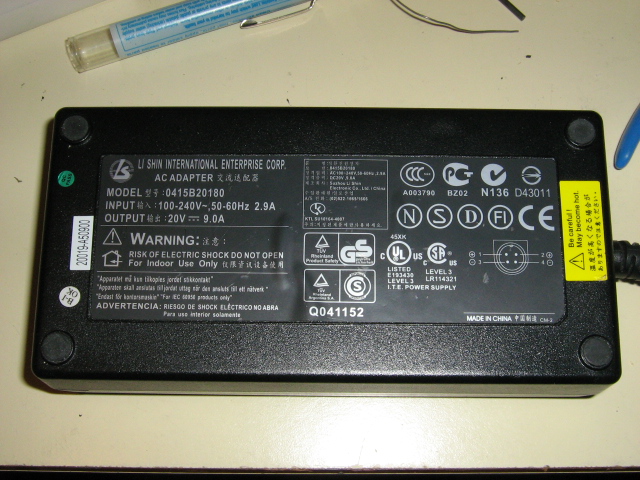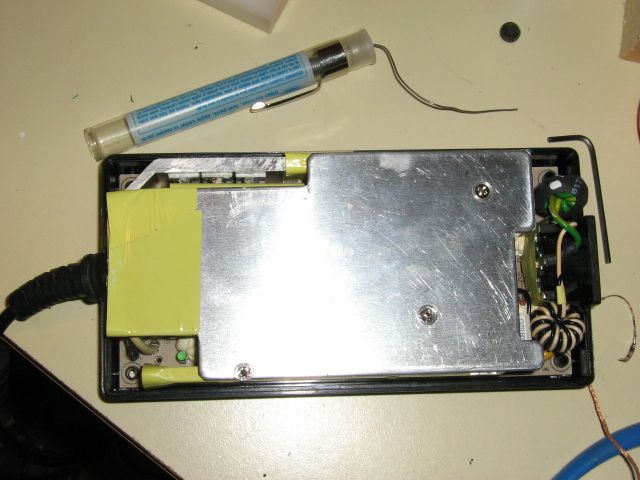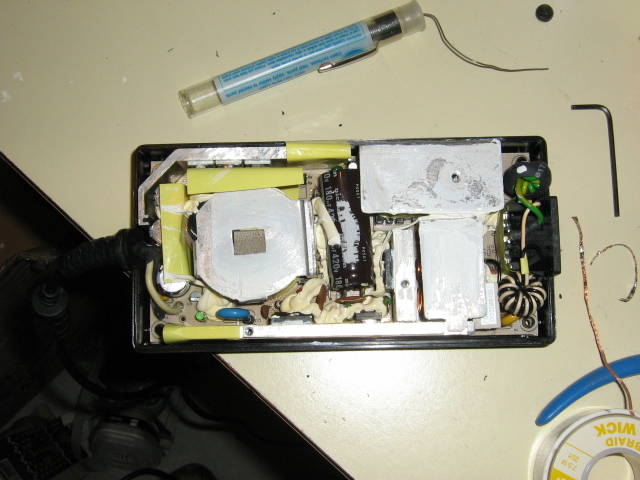-
Alien Autopsy: The Death of an Alienware Powersupply
This is the story of my autopsy of my Alienware 7700m laptop powersupply. (Full images found on my Flickr account, jarod997). One day, not too long after turning on my machine, after XP had booted up (darn, I can't blame this one on Vista :whistler:) I heard a "poof" and the computer shut off. Heat? No, the room was cool. Did the power strip trip? No, the speakers were still on and in that case it couldn't be a power failure either. Wait... *snif snif* oh, that's not good. I look at the brick, no power LED, unplug it, bring it up to my nose and, yup, *snif* fried electronic smell. Mind you, it wasn't dead fish smell, so it wasn't a cap that blew. (Thank goodness, my 4 1/2 month daughter who was next to me might have lost her breakfast.) So here we go on an autopsy journey to determine if this unit can be repaired. The immediate suspects are moving parts (which there are none), capacitors (no dead fish smell, so again not my first concern). Next is a fuse and power resistors. After which we could look at power regulators. In that order
-
Re: Alien Autopsy: The Death of an Alienware Powersupply
Here we have the brick, Li Shin International, blah blah... the sticker says it all. :) Oddly enough, on the Li Shin International web page, when I do a model number lookup the search engine says "not found" - nor do they list power supplies as a product they sell. Hmmm. :P
-
Re: Alien Autopsy: The Death of an Alienware Powersupply
The specifics: 20v (a tad higher than average supplies, ok) 9 amps! Woa, that's a tad much. Caution, 9 amps is more than enought to do SERIOUS INJURY AND/OR DEATH! The average user should not attempt what I'm about to do.
That being said, I am now going to ingore the warning "Risk of electric shock do not open".
-
Re: Alien Autopsy: The Death of an Alienware Powersupply
Quote:
Originally Posted by
nevermind1534

You forgot the [/url] tag.
You could just use image tags with it, like this
Woot, got it, thnx :)
-
Re: Alien Autopsy: The Death of an Alienware Powersupply
I've always wanted to take one of those apart.
Don't get killed :D
-
Re: Alien Autopsy: The Death of an Alienware Powersupply
We begin the operation by locating the footpads and removing them. (Where else to manufacturers hide their screws? Oh ya, stickers. ;) ) At first glance it looks like a hex wrench type bolt. I locate an apporpriately sized hex wrench and begin to remove the first screw. After having a bit of difficulty, I take a close look at the screw head, nope, not a hex, but a mini torx. Luckily my wife has just the screwdriver bit in her toolkit (yea, go wife!). The other three come out without any problems.
-
Re: Alien Autopsy: The Death of an Alienware Powersupply
Upon removal of the cover we find, (aside from a broken screw mount), a large aluminum plate. *grr* well, this doesn't help much. This is probably some persons wise idea of a heat sink. Ok, yes, it does work like a heat sink, the plastic case does get hot, but where does the heat go from there? It would have to go from the aluminum plate, through the air (both into and out of the unit), through the plastic, and then out to freedom outside the unit. (See my notes at the end of the post.) Not the best idea IMHO. Well, off it comes.
-
Re: Alien Autopsy: The Death of an Alienware Powersupply
We continue to expose the wound by removing three screws and set them aside. And off comes... um.. off comes the... *grrr* now what? We take out the flat head screwdriver and begin some careful prying. It appears that there was a good amount of thermal compound and a piece of double sided foam on the main capacitor.
We note here that on the AC side (right) they coil the hot and neutral lines (below the connector) and they also coil the ground (above the connector). We also note the (over?) use of aluminum heat plates, isolation plastic and (for lack of a better term) goo.
-
Re: Alien Autopsy: The Death of an Alienware Powersupply
We now carefully remove the interior brick, being careful not to touch the bottom of the circuit board. Upon further examination of the brick, we do not see any visable fuse, either the traditional kind, compact or otherwise. We do not see any browning or excess carbon either. Hm, ok, what's on the bottom?
-
Re: Alien Autopsy: The Death of an Alienware Powersupply
*Gah* Another plate! This one is soldered in. So, out comes the solder iron and the solder wick (great stuff, when used correctly) and off it comes. Again, a little prying is needed as there are some thermal pads keeping the insulating plastic card off the bottom of the circuit board. Ha ha! Protovision I have you now! (Points if you can name that quote! Ed: No points if you look it up :P )
-
Re: Alien Autopsy: The Death of an Alienware Powersupply
You don't have to make a post for every picture...
-CollinstheClown
-
Re: Alien Autopsy: The Death of an Alienware Powersupply
Quote:
Originally Posted by
Collinstheclown

You don't have to make a post for every picture...
-CollinstheClown
I think he's taking a picture, uploading it, doing some more work, then repeats the process.
-
Re: Alien Autopsy: The Death of an Alienware Powersupply
So, under the bottom plate we have a whole lot of Surface Mount Technology stuff. Again we check for signs of brown scorching, black carbony soot, burned out pieces. Nothing found off the bat. Again, no signs of fuses. And what's this goo again? Ah ha! This is insulative compound. They've put this goo on top of the solder connections for the aluminum heat blocks on the other side of the board. So, if they can't use plastic, they've used goo. The nice thing about goo is that it's easy to apply and thermally resistant (it won't break down with heat). The (insert choice of word here) bad thing about this goo is it's fairly permenant. I have a difficult time moving any of this goo without damaging the board, unless it's really thin.
-
Re: Alien Autopsy: The Death of an Alienware Powersupply
Quote:
Originally Posted by
nevermind1534

I think he's taking a picture, uploading it, doing some more work, then repeats the process.
Actually, hehe, I did all the work first, did the photos in reverse, and now I'm posting them. I find it's easier to navigate and people can comment on any particular step if I break it up. But thanks for the advice.
-
Re: Alien Autopsy: The Death of an Alienware Powersupply
Here we have the main exit cap, 180uF and 420V, good and solid. No visible signs of anything frying here.
Here we have the main exit coil - this looks very solid. Heck for 9 amps DC, you'd expect something like this. No visible signs of anything frying over here either.
There are a few power regulators bolted to aluminum heat blocks, could I take these all out and test them, ya I could but I think it's more work that this thing is worth at this point. Even then I might not have found all the damage.
Oh ya, more goo.
-
Re: Alien Autopsy: The Death of an Alienware Powersupply
So, in the end, I didn't find any obvious signs of something blowing up. No components were visably brown or black, no charring, no obvious scent of "burn" or "dead fish". This power supply is also too complex to try and trace from AC to DC with a multi-meter. *sigh* At least it was fun.
IF you have an Alienware power supply (for a laptop), I would strongly suggest that you (or some techy type person you know) mod a nice big fan and slots into the case. You can pony the fan off the output with an appropriate resistor, OR (heh heh) get a 120VAC fan and pipe it off the input. :D Fan on the top, slots on the bottom or bottom sides. That's what I'm planning on doing once I get a replacement. Photos of that to come later... when my wife lets me use her mac again.
-
Re: Alien Autopsy: The Death of an Alienware Powersupply
The pic by pic is great for sending a link to what does what.
I've enjoyed this, I should show you the finger that's missing part of the tip because of one of these...
-
Re: Alien Autopsy: The Death of an Alienware Powersupply
Quote:
Originally Posted by
Kayin

The pic by pic is great for sending a link to what does what.
I've enjoyed this, I should show you the finger that's missing part of the tip because of one of these...
I should show you the tip thats missing on my swiss army knife due to 120VAC and the tip that's missing on my multimeter probe from 12 VDC at about 1 amp. :)
-
Re: Alien Autopsy: The Death of an Alienware Powersupply
Update: Well, I have the replacement brick on order along with two 70mm fans and a couple nice grills. I'll post that mod in the mod forums and provide a link... right here!
-
Re: Alien Autopsy: The Death of an Alienware Powersupply
I would check your output line for shorts or breaks that's what was wrong with my dell power brick and there was a slightly audible beeping when it would short.
-
Re: Alien Autopsy: The Death of an Alienware Powersupply
Have you tried checking it for dry joints. As these power supplies are known for running hot, one might have been created over its lifetime. Try checking around the out put fet's
-
Re: Alien Autopsy: The Death of an Alienware Powersupply
Quote:
Originally Posted by
Snowman

I would check your output line for shorts or breaks that's what was wrong with my dell power brick and there was a slightly audible beeping when it would short.
I plugged it back in after I was done my autopsy just to be sure some "magic" hasn't happened, as I've had before, and there were no more extra smells or sounds. But, I'll give it a try and have a look.
I did accidentily try to put my power plug in my laptop um, upside down once (I think) and I heard a good size "snap"! Oops, not the correct alignment. 9 Amps can make a good arc. Hmmm, I'm gonna see if I can find some arcing photos I took (on purpose) and I'll post the tips of my swiss army knife and multi-meter probes.
-
Re: Alien Autopsy: The Death of an Alienware Powersupply
Quote:
Originally Posted by
smray

Have you tried checking it for dry joints. As these power supplies are known for running hot, one might have been created over its lifetime. Try checking around the out put fet's
What do you mean, "dry" joints? Pads where the solder has sublimated? (Unlikely)
-
Re: Alien Autopsy: The Death of an Alienware Powersupply
As promised, here are some photos. For the full description (and size) please see my Flickr page.
A disposable camera flash unit, the main capacitor being shorted. Note: 1.5 VDC AA battery.
A slightly cooler pic of the same thing - in a dark room.
What 120 VAC can do to your swiss army knife can opener. (Don't ask.)
What a run-away power supply (20+ VDC @ 1 amp) can do to your multi-meter probes.
-
Re: Alien Autopsy: The Death of an Alienware Powersupply
Quote:
Originally Posted by
Jarod997

What do you mean, "dry" joints? Pads where the solder has sublimated? (Unlikely)
No, what I'm talking about is the possibility that the power supply came from the factory with some badly soldered joints that over time, as the power supply was repeatedly heated up and cooled down that the flux that was used caused the joint to weaken and then eventually crack/break.
-
Re: Alien Autopsy: The Death of an Alienware Powersupply
Quote:
Originally Posted by
smray

No, what I'm talking about is the possibility that the power supply came from the factory with some badly soldered joints that over time, as the power supply was repeatedly heated up and cooled down that the flux that was used caused the joint to weaken and then eventually crack/break.
Ohhhh, ya, ok I get it. I don't recall seeing any lifted pads or disconnected components. The construction looked pretty solid, if not a bit undercooled. ;)















